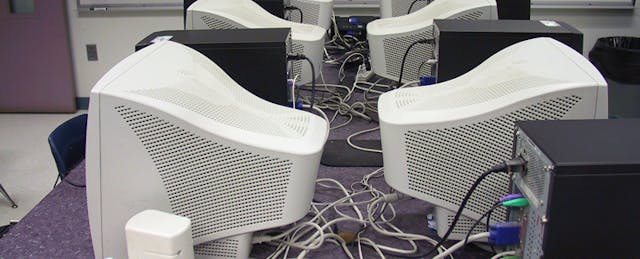My co-founder and I at Playmation Studios are exploring how our English language learning program can be used in schools, so I spent a few weeks interviewing teachers and administrators, culminating my experience with an observation of a computer lab at E.R. Taylor Elementary School in San Francisco.
We want our software to be used by the largest number of students as possible, students who might not otherwise have access to our programs because they don’t have a computer at home. At the end of 2010, 23% of homes still did not have a computer, according to a report by the Economics and Statistics Administration. As our program focuses on reading and auditory comprehension, I imagined our tool could be particularly useful for struggling ESL students.
The truth, however, is that a large number of our students in this country, particularly elementary school students in public schools, only have real access to computers once a week when they visit a computer lab.
Experiencing an elementary school computer lab in action was an incredibly eye opening experience. The lab had 30 computers distributed across 3 rows of desks. A single teacher was charged with managing the 25-30 students that would rotate through each class period. Key observations:
- Students at schools like E.R. Taylor only have a single computer class period a week. The short duration of exposure is exasperated by the time needed to get settled down at the computer and get started. The result is that students probably only have about a half hour of focused computer use each week.
- Given how severely under-resourced so many of our schools are, the computers can be incredibly old. The computers in this lab were nine years old. As a result they were painstakingly slow and students would often need to switch computers part way through the class.
- There is a wealth of pretty great online programs for students that are free. Some of these, like Sumdog, the students literally cannot get enough of.
- 25-30 students in a computer lab is a lot to manage for even the most amazing teachers. Remember how little time these students already have with a computer? They also have to wait their turn for individualized help whenever a question comes up.
What became painfully clear is that as edupreneurs we are creating technology that is competing for a brief 30 minutes a week and is therefore not accessible to the most at need students.
This time constraint also underscores the importance for educational technology to have intuitive and seamless user interfaces. Teachers have enough on their hands managing students on computers; we can’t let valuable educational time go toward children struggling with a poorly designed UI. Logging in can demand far too much time and needs to be made as simple as possible.
In addition, because of the abundance of free programs and the obvious paucity of resources devoted to technology, it would be nearly impossible to reach the students in this school with a program that was anything other than free.
If a motivation to build technology for schools is to help close the achievement gap, as edtech innovators I am calling on all of us to still find a way to reach these students. Even more imperatively, I hope that we can find a way to get greater computer access into all public schools, because no matter what incredible programs we make as edupreneurs, a half hour with technology a week is not nearly enough time.
We are considering starting a nonprofit arm within a couple years of launch that would use proceeds from our for-profit arm to get our programs into these schools. The nonprofit arm would give away Playmation to under resourced schools for free and donate computers.
A big thank you to Karen Mcgarrah for allowing me to observe E.R. Taylor School’s computer lab in action. Karen is also heading up CUE SF, a group supporting tech integration in the K-12 classroom. After I drafted this article, Karen shared the good news that they are finally getting some new PCs within the next couple of weeks.


